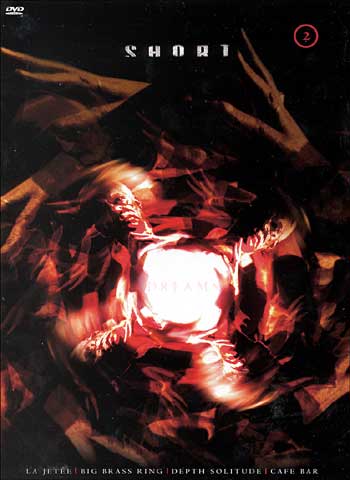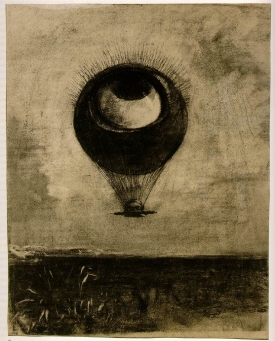Return
to DVDBeaver
 |
ODILON
REDON: THE EYE LIKE A
STRANGE BALLOON (1996)
Directed
by Guy Maddin
4
minutes and 31 seconds
16mm,
B&W (monochrome)
Available
on the DVD Short 2: Dreams (formerly Short Cinema Journal Vol.
2)
DVD
produced by Warner Brothers Ó
2000
Special
Features for Odilon Redon:
·
Production notes
·
Commentary by Guy Maddin
·
Storyboards (via alternate angle feature)
Reviewed
by Richard Malloy (aka “Al Brown”)
|

MoMA, NY (1878)
Commissioned by the BBC to create a short film inspired by
a favorite work of art, Canadian avant-garde filmmaker, Guy Maddin, selected The
Eye Like a Strange Balloon Mounts Toward Infinity, a charcoal sketch by the
leading French Symbolist, Odilon Redon (1840-1916). Redon's piece was part of a
series of illustrations he created for Charles Baudelaire’s French
translations of the works of Edgar Allen Poe.
As Redon took a certain impressionistic distance from
Poe’s text, Maddin does likewise with Redon’s illustration. Though one shot is a direct cinematic rendering of the title
work, Maddin was not really interested in duplicating Redon’s drawings or
following the narrative of Poe’s text. Instead,
he sought to broadly emulate the black, smudgy texture of Redon’s charcoal,
which he describes as “oily as a train engine,” and took narrative
inspiration from the silent film, La Roue
(1922), by one of his favorite filmmakers, Abel Gance.
Whereas Gance’s epic originally ran a full 8 hours, the BBC limited
Maddin’s submission to “4 minutes, and not one frame more.”
Should you find the narrative a tad murky in sections, understand that a
rather significant amount of redaction was inevitable.
The story, though fairly simple and straightforward,
may well be lost to the casual viewer beneath the endlessly bizarre imagery and
intricately layered soundtrack. Like
Gance’s La Roue, it is a
love-triangle between a father, his son, and an orphan girl who joins them on
their great railway journey across the surreal landscape of life.
Each character is conveniently identified by name-tag: the father,
Keller, the son, Caellum, and the orphan girl, Bernice.
When we first meet K & C, they are happily riding the rails, a proud
father and his young, adoring son. Within
the first 60 seconds, we are witness to C’s sexual maturing, dramatized by the
flash of a beard sprouting across his face (spreading from one ear to the other
in time-lapse fashion) and his emergence from a giant boulder-like snail-shell
cladding his lower body. It cracks
open with an ominous explosion, and an adult actor emerges to take over the role
of C. K & C soon come upon the
comely Bernice, still clad in her juvenile shell.
B joins them on their journey and quickly becomes K’s favorite.
Soon, B’s shell also breaks away, she emerges into maturity, and the
inevitable sexual tension is born.
The rest I leave for you to decipher, though pay
particular attention to the jackhammer teeth-chattering, the image of the
double-blinded father, the son’s head hanging like plump fruit from a Dali-esque tree, and the eaten beard. This
film is a catalog of exquisitely rendered, dark dream imagery.
Maddin’s original cut ran 5-1/2 minutes and he
concedes that the 4 minute cut came at the expense of narrative clarity, such
that the images appear to be ‘dealt out like a pack of cards’.
As with an earlier experience of being asked to pad out a film to feature
length for exhibition (Tales from the
Gimli Hospital), the easy-going Maddin complied and, in both instances,
placed his stamp of approval upon the final cut (without stating a preference).
Although the film is timed at 5:11 on the packaging, it is, in fact,
precisely 4 minutes – plus about 30 seconds for the credits.
Regarding the quality of the transfer, it is
difficult to tell whether a particular hazy, murky or otherwise distressed image
is Maddin’s doing or otherwise. From
the high quality of the other, more conventionally shot films in this collection
and the lack of any pixelation or other obvious digititis, it seems safe to
pronounce it a very good, if not excellent transfer.
Worth mentioning, however, is a peculiar, tiny, white silhouette of a
camera superimposed like a TV network logo in the upper part of the screen just
right of center. It appears to have
been added after-the-fact and remains totally unexplained.
Though present throughout, it quickly recedes from prominence amid the
busy mise-en-scene and is not overly
distracting.
The film features Maddin’s typical, densely-layered
scoundscape, replete with hissing, steam-spewing clamshells, the incessant chu-chu-chu-ing
of the train and tacka-tacka-tacka
of the rails, the intermittent sounds of teeth being brushed and great waves
crashing against rocky shores, and a single line of dialog: “Oh
the humanity!” Judging sound
quality is hindered for the same reasons as the video, but by reference to other
films on this disc, one may presume that it is an accurate reflection of the
original mix. As with all the
commentary tracks accompanying the various short films on this disc, Maddin’s
sounds, quite literally, phoned-in. But
he provides an insightful and nuanced commentary in his typically engaging
style, detailing just the sort of information a curious viewer would be
interested in knowing. Brief but
informative production notes are included, as well as an alternate angle feature
displaying Maddin’s rudimentarily drawn storyboards.
A Note to the Perplexed: One
might be inclined to wonder why anyone other than a bona fide Guy Maddin fanatic
would be moved to purchase a DVD for a single, four minute film, regardless of
how interesting or innovative it may be. Certainly,
one would not likely be so moved even at its relatively inexpensive price of
$10-12. But in addition to Maddin’s
film and a veritable trove of wonderful short features (including Bride
of Resistor, Depth Solitude, A Guy Walks Into a Bar and the original short
version of Big Brass Ring), there is
also Chris Marker’s La Jetée (1962),
the 30-minute science fiction classic that inspired Terry Gilliam’s 12
Monkeys. Marker’s film is one of the true landmarks in the history of
cinema and something no sci-fi aficionado or lover of experimental cinema should
be without. So why not review La
Jetée, you ask? Simply because
it’s a film that’s received so much critical recognition and appreciation
over the years that any review I could muster would be completely superfluous.
Suffice to say that it is fascinating, mesmerizing, thought-provoking and
– for one brief moment – utterly transcendent.
Awards: Best Canadian Short Film - Special Jury Citation,
1995 Toronto International Film Festival
Odilon Redon mini-bio CLICK
HERE
Abel Gance’s La
Roue CLICK
HERE
Review of Guy Maddin's Careful (1992) CLICK
HERE
Return
to DVDBeaver

